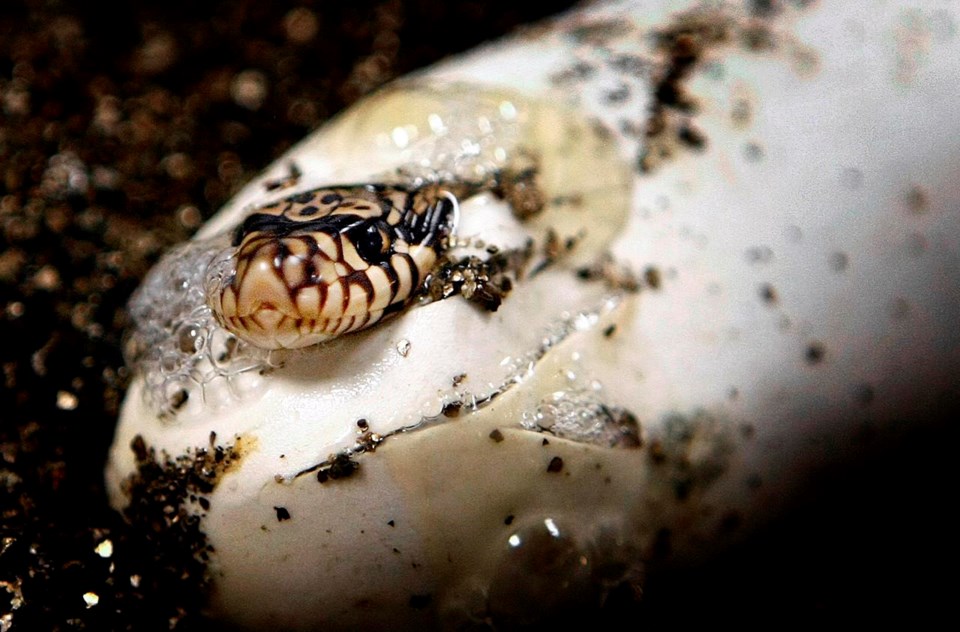NEW ORLEANS (AP) ΓÇö Four areas in Louisiana and two in Texas should be protected as critical habitat for a that eats pocket gophers and takes over the rodents' burrows, the federal government says.
Louisiana pinesnakes, which produce the largest eggs and hatchlings of any U.S. have been since 2018.
Their decline is largely due to the drastic reduction and fragmentation of grassy with sandy soil. And since Louisiana pinesnakes' 5-inch-long (12.7-centimeter) eggs are so big that they lay only three to five at a time, losses are hard to replace.
The snakes grow to 5 feet long (1.5 meters) but are hard to count because they spend more than half their time underground. They also are camouflaged on brown pine needles, with black, brown and russet patches on a buff to yellowish background.
National forests cover most of four areas that the U.S. Fish and Wildlife Service has proposed as critical habitat. Private land ΓÇö including some covered by conservation agreements ΓÇö comprises all of the smallest, in Texas, and virtually all of the biggest, in north Louisiana where the largest known population lives.
Critical habitat is a limited protection, affecting only contracts using federal money or requiring federal permits. Other critical habitat decisions have and for such designation.
In north Louisiana's Bienville Parish, private owners hold more than 99% of a proposed area about the size of Milwaukee ΓÇö roughly 95 square miles (246 square kilometers). The smallest area, about 8 square miles (20 square kilometers) in ScrappinΓÇÖ Valley, Texas, is all privately held.
However, the ScrappinΓÇÖ Valley land is already managed for endangered little which also need open-canopied pine savannas, said Don Dietz, consulting biologist for a family that owns 70% of the land.
ΓÇ£Red-cockaded woodpeckers eat a lot of ants, which need the open area below. So the habitat is essentially the same,ΓÇ¥ Dietz said.
Noah Greenwald, endangered species director at the environmental nonprofit Center for Biological Diversity, said, ΓÇ£Far too few private landowners care about nature and ensuring species like the Louisiana pinesnake survive. When it does happen it's really great."
The Fish and Wildlife Service said two of seven known pinesnake populations are in Texas, but Dietz was dubious. He said he tried unsuccessfully for a decade to trap Louisiana pinesnakes to prove they lived in Scrappin' Valley.
ΓÇ£I want to believe thereΓÇÖs some out there, but in Texas there may not be,ΓÇ¥ Dietz said.
Other populations live in Louisiana's Bienville, Grant, Natchitoches, Sabine, and Vernon parishes, the federal agency said.
Big Cypress State Park makes up about 0.5% of the proposed Bienville unit. Another 8.4 square miles (22 square kilometers) are part of a conservation agreement benefiting the snake, according to Fish and Wildlife's economic analysis.
The Weyerhaeuser Co. announced in 2020 that it had a 30-year agreement to
Weyerhaeuser said it is working to understand how the federal proposal ΓÇ£would overlap and potentially impact the acres of critical habitat we are currently protecting for the Louisiana pinesnake.ΓÇ¥
The company said in 2020 that state and federal biologists helped it identify two areas totaling about 2.8 square miles (7.25 square kilometers) as the most important for the snake. It said it would convert about 440 acres (180 hectares) from loblolly to longleaf pine and keep another 1,383 acres (560 hectares) with an open canopy and grassy forest floor.
Wildlife and Fisheries wouldnΓÇÖt say whether Weyerhaeuser's longleaf conversion and open canopy areas are within the proposed federal critical habitat.
Wherever they are, it ΓÇ£isnΓÇÖt really enough to help the Louisiana pinesnake on Weyerhaeuser land," Greenwald said. Louisiana pinesnake populations need blocks of more than 11 square miles (28.5 square kilometers) of mostly unfragmented habitat, according to the federal analysis.
Also proposed as critical habitat in Louisiana are about 89 square miles (230 square kilometers) in Rapides Parish, more than 68 square miles (176 square kilometers) in Vernon Parish and about 41 square miles (106 square kilometers) in Grant Parish. Different parts of the Kisatchie National Forest make up most of each.
The second Texas area would cover nearly 25 square miles (65 square kilometers) in Angelina and Jasper counties, mostly in the Angelina National Forest.
___
To see all of APΓÇÖs environmental coverage, visit
Janet Mcconnaughey, The Associated Press



